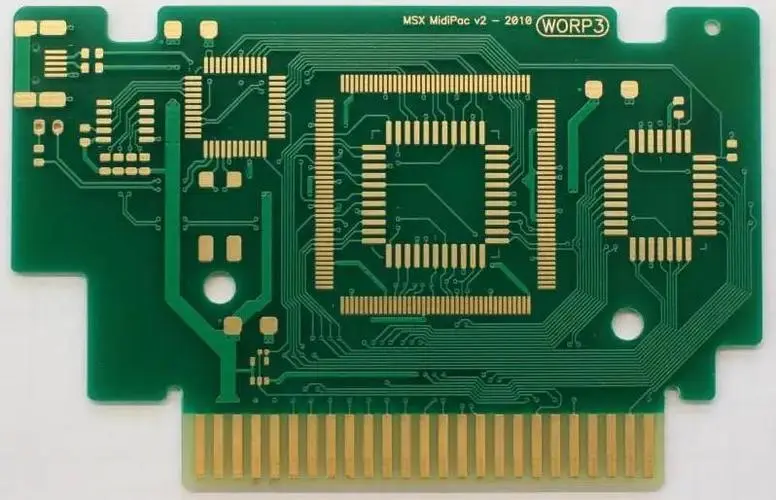
The basic performance of edge finger connector can be divided into three categories: mechanical properties, electrical properties and environmental performance.

1. Mechanical properties
As far as the connection function is concerned, the pull-out force is an important mechanical property. Plugging force is divided into insertion force and pull-out force (pull-out force is also called separation force), the requirements of the two are different. The maximum insertion force and minimum separation force are stipulated in the relevant standards, which indicates that the insertion force is smaller from the point of view of use (hence the structure of LIF with low insertion force and ZIF without insertion force), and if the separation force is too small, the reliability of contact will be affected. Another important mechanical property is the mechanical life of the connector. Mechanical life is actually a durability index, which is called mechanical operation in national standard GB5095. It takes one insertion and one pull-out as a cycle to judge whether the connector can normally complete its connection function (such as contact resistance value) after the specified insertion and pull-out cycle.
The insertion force and mechanical life of the edge finger connector are related to the contact structure (positive pressure), the coating quality (sliding friction coefficient) at the contact area and the contact arrangement dimension accuracy (alignment). It is also related to surface treatment, especially electroplating technology. The factors affecting the material change during the pretreatment and electroplating process include hydrogen embrittlement, stress and crystal change in the coating.
The basic performance of edge finger connectors can be divided into three categories: mechanical properties, electrical properties and environmental performance.
1. Mechanical properties
As far as the connection function is concerned, the pull-out force is an important mechanical property. Plugging force is divided into insertion force and pull-out force (pull-out force is also called separation force), the requirements of the two are different. The maximum insertion force and minimum separation force are stipulated in the relevant standards, which indicates that the insertion force is smaller from the point of view of use (hence the structure of LIF with low insertion force and ZIF without insertion force), and if the separation force is too small, the reliability of contact will be affected. Another important mechanical property is the mechanical life of the connector. Mechanical life is actually a durability index, which is called mechanical operation in national standard GB5095. It takes one insertion and one pull-out as a cycle to judge whether the connector can normally complete its connection function (such as contact resistance value) after the specified insertion and pull-out cycle.
The insertion force and mechanical life of the edge finger connector are related to the contact structure (positive pressure), the coating quality (sliding friction coefficient) at the contact area and the contact arrangement dimension accuracy (alignment). It is also related to surface treatment, especially electroplating technology. The factors affecting the material change during the pretreatment and electroplating process include hydrogen embrittlement, stress and crystal change in the coating.
For RF coaxial connectors, there are also electrical indicators such as characteristic impedance, insertion loss, reflection coefficient, voltage standing wave ratio (VSWR). Due to the development of digital technology, in order to connect and transmit high-speed digital pulse signals, a new type of connector, namely high-speed signal connector, has emerged. Accordingly, in terms of electrical performance, besides characteristic impedance, there are also some new electrical indicators, such as crosstalk, transmission delay, skew and so on.
3. Environmental Performance of Edge Finger Connector
Common environmental properties include temperature resistance, moisture resistance, salt spray resistance, vibration and impact resistance. Although these tests are carried out in the form of whole devices, the most tested one is the surface electroplating. When the surface electroplating cannot withstand the tests of temperature, humidity and salt fog resistance, the product will be unqualified, and other performances will not be meaningful even if they pass.
(1) Temperature resistance. At present, the highest working temperature of the connector is 200 C (except for a few high temperature special connectors), and the lowest temperature is – 65 C. When the connector works, the current generates heat at the contact point, which leads to temperature rise. Therefore, it is generally believed that the working temperature should be equal to the sum of ambient temperature and contact temperature rise. In some specifications, the maximum allowable temperature rise of the connector at rated operating current is specified explicitly.
(2) Invasion of moisture will affect the insulation performance of connectors and corrode metal parts. The constant humidity and heat test conditions are 90%-95% (according to product specifications, up to 98%) and temperature (40 + 20). The test time is at least 96 hours according to product specifications. Alternating humidity and heat tests are more rigorous.
(3) When the salt fog resistant connector works in the environment containing moisture and salt, the surface treatment layer of its metal structure and contact parts may produce electrochemical corrosion, which affects the physical and electrical properties of the connector.
In order to evaluate the ability of electrical connectors to withstand this environment, salt spray test is prescribed. The connector is suspended in a temperature controlled test box and sprayed by compressed air with a prescribed concentration of sodium chloride solution to form a salt mist atmosphere. The exposure time is prescribed by the product specifications for at least 48 hours.
(4) Vibration and shock resistance is an important performance of electrical connectors, especially in special application environments such as aviation and aerospace railway and highway transportation. It is an important index to test the mechanical structure of electrical connectors and electrical contact break seams. There are clear provisions in the relevant test methods. Peak acceleration, duration, shock pulse type and time of electrical continuity interruption should be specified in shock test.
(5) Other environmental performance. According to the use requirements, other environmental properties of electrical connectors include sealing (air leakage, liquid pressure), liquid impregnation (oxidation resistance to specific liquids), low pressure and so on.